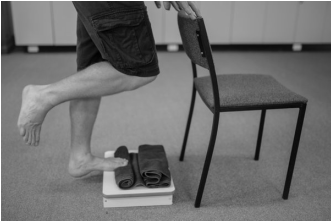 Three thousand years ago King Solomon wrote: "...Of making many books there is no end, and much study is a weariness of the flesh" (Ecclesiastes 12:12). Now, I am of the opinion that one can never have too many books. The New York Times reports on a Scandinavian study of plantar fasciitis: Plantar Fasciitis Relief By GRETCHEN REYNOLDS SEPTEMBER 15, 2014 Question: Can I get relief for plantar fasciitis? Answer: If you have stairs or a sturdy box in your home and a backpack, timely relief for plantar fasciitis may be possible, according to a new study of low-tech treatments for the condition. Plantar fasciitis, the heel pain caused by irritation of the connective tissue on the bottom of the foot, can be lingering and intractable. A recent study of novice runners found that those who developed plantar fasciitis generally required at least five months to recover, and some remained sidelined for a year or more. Until recently, first-line treatments involved stretching and anti-inflammatory painkillers such as ibuprofen or cortisone. But many scientists now believe that anti-inflammatories are unwarranted, because the condition involves little inflammation. Stretching is still commonly recommended. But the new study, published in August in the Scandinavian Journal of Medicine & Science in Sports, finds that a single exercise could be even more effective. It requires standing barefoot on the affected leg on a stair or box, with a rolled-up towel resting beneath the toes of the sore foot and the heel extending over the edge of the stair or box. The unaffected leg should hang free, bent slightly at the knee. Then slowly raise and lower the affected heel to a count of three seconds up, two seconds at the top and three seconds down. In the study, once participants could complete 12 repetitions fairly easily, volunteers donned a backpack stuffed with books to add weight. The volunteers performed eight to 12 repetitions of the exercise every other day. Other volunteers completed a standard plantar fasciitis stretching regimen, in which they pulled their toes toward their shins 10 times, three times a day. After three months, those in the exercise group reported vast improvements. Their pain and disability had declined significantly.Those who did standard stretches, on the other hand, showed little improvement after three months, although, with a further nine months of stretching, most reported pain relief. The upshot, said Michael Skovdal Rathleff, a researcher at Aalborg University in Denmark, who led the study, is that there was “a quicker reduction in pain” with the exercise program, and a reminder of how books, in unexpected ways, can help us heal. This research is discussed here: Strength training better than stretching for plantar fasciitis Clinical question Is strength training more effective than stretching for patients with plantar fasciitis? Bottom line A regimen of strength training (specifically, heel raises) improves pain and function in patients with plantar fasciitis faster than a typical stretching regimen. Over time, though, patients who stretch will continue to improve and have similar improvement. (LOE = 1b-) Reference Rathleff MS, Molgaard CM, Fredberg U, et al. High-load strength training improves outcome in patients with plantar fasciitis: A randomized controlled trial with 12-month follow-up. Scand J Med Sci Sports 2014 (e-publication). doi: 10.1111/sms.12313 Study design Randomized controlled trial (nonblinded) Funding Foundation Allocation Uncertain Setting Outpatient (specialty) Synopsis These Danish researchers recruited 48 consecutive patients referred for physical therapy for the treatment of plantar fasciitis. All patients had heel pain for at least 3 months and had ultrasound-confirmed plantar fascia thickness of at least 4.00 mm. All patients received Tuli's Polar Bears gel heel cups and were then randomized, concealed allocation uncertain, to plantar-specific stretching or strength training. The stretching regimen consisted of crossing the affected heel over the opposite knee and pulling the toes back for 10 seconds, repeated in sets of 10 three times a day. The strength-training group performed heel lifts from a raised platform (eg, a step), with a rolled towel placed under the toes to cause maximum dorsiflexion (see a picture at http://tinyurl.com/plantarstrength). The regimen is progressive and rigorous (see outline below). The Function Foot Index, a measure of self-reported pain, disability, and function ranging from 0 to 230, was used to measure benefit. After 3 months, scores in the strength-training group were 29 points better than in the stretching group (95% CI 6 - 52). However, at 6 months and 12 months the stretching group continued to improve and their scores were not significantly different from the strength-training group’s scores. High-load strength training: Heel raises are performed on a raised platform with a rolled-up towel under the toes to cause maximum dorsiflexion. Raise the heels over 3 seconds, hold for 2 seconds, and then lower over 3 seconds. Complete 3 sets of 12 repetitions every other day using one leg unless 12 cannot be performed. After 2 weeks, increase the load by wearing a backpack filled with books, reduce the repetitions to 10 per set, and increase to 4 sets After 2 more weeks, increase the load again (add more books to your backpack) and perform 8 repetitions, 5 sets.
0 Comments
Leave a Reply. |
AuthorDavid is a fan of books and no doubt will be sharing some good reads here. Archives
February 2024
Categories
All
|
 RSS Feed
RSS Feed